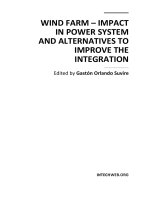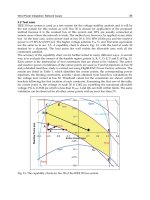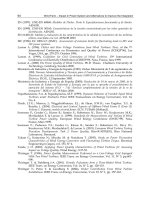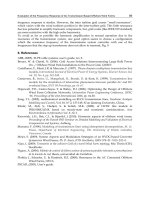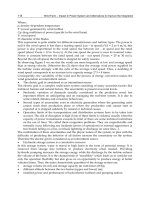Wind Farm Impact in Power System and Alternatives to Improve the Integration Part 1 ppt
Bạn đang xem bản rút gọn của tài liệu. Xem và tải ngay bản đầy đủ của tài liệu tại đây (604.3 KB, 25 trang )
WIND FARM – IMPACT
IN POWER SYSTEM
AND ALTERNATIVES TO
IMPROVE THE
INTEGRATION
Edited by Gastón Orlando Suvire
Wind Farm
–
Impact in Power System and Alternatives to Improve the Integration
Edited by Gastón Orlando Suvire
Published by InTech
Janeza Trdine 9, 51000 Rijeka, Croatia
Copyright © 2011 InTech
All chapters are Open Access articles distributed under the Creative Commons
Non Commercial Share Alike Attribution 3.0 license, which permits to copy,
distribute, transmit, and adapt the work in any medium, so long as the original
work is properly cited. After this work has been published by InTech, authors
have the right to republish it, in whole or part, in any publication of which they
are the author, and to make other personal use of the work. Any republication,
referencing or personal use of the work must explicitly identify the original source.
Statements and opinions expressed in the chapters are these of the individual contributors
and not necessarily those of the editors or publisher. No responsibility is accepted
for the accuracy of information contained in the published articles. The publisher
assumes no responsibility for any damage or injury to persons or property arising out
of the use of any materials, instructions, methods or ideas contained in the book.
Publishing Process Manager Romina Krebel
Technical Editor Teodora Smiljanic
Cover Designer Jan Hyrat
Image Copyright Yegor Korzh, 2010. Used under license from Shutterstock.com
First published July, 2011
Printed in Croatia
A free online edition of this book is available at www.intechopen.com
Additional hard copies can be obtained from
Wind Farm
–
Impact in Power System and Alternatives to Improve the Integration,
Edited by Gastón Orlando Suvire
p. cm.
ISBN 978-953-307-467-2
free online editions of InTech
Books and Journals can be found at
www.intechopen.com
Contents
Preface IX
Part 1 Impact of Wind Power Generation on the Electric System 1
Chapter 1 Impact of Wind Farms in Power Systems 3
Mónica Alonso and Hortensia Amarís
Chapter 2 Wind Power Integration: Network Issues 21
Sobhy Mohamed Abdelkader
Chapter 3 Voltage Fluctuations Produced
by the Fixed-Speed Wind Turbines
during Continuous Operation
- European Perspective 43
Carlos López and Jorge Blanes
Chapter 4 Evaluation of the Frequency Response
of AC Transmission Based Offshore Wind Farms 65
M. Zubiaga, G. Abad, J. A. Barrena,
S. Aurtenetxea and A. Cárcar
Part 2 Alternatives to Mitigate Problems
of the Wind Power Integration 91
Chapter 5 FACTS: Its Role in the Connection of
Wind Power to Power Networks 93
C. Angeles-Camacho and F. Bañuelos-Ruedas
Chapter 6 Optimal Management of Wind Intermittency
in Constrained Electrical Network 109
Phuc Diem Nguyen Ngoc, Thi Thu Ha Pham,
Seddik Bacha
and Daniel Roye
Chapter 7 Intelligent Control of Wind Energy
Conversion Systems 145
Abdel Aitouche
and Elkhatib Kamal
VI Contents
Chapter 8 Operation and Control of Wind Farms in
Non-Interconnected Power Systems 171
Ioannis D. Margaris, Anca D. Hansen, Nicolaos A. Cutululis,
Poul Sørensen and Nikos D. Hatziargyriou
Chapter 9 Short-Term Advanced Forecasting and Storage-Based
Power Quality Regulation in Wind Farms 209
Juan Mendez and Javier Lorenzo
Chapter 10 Dynamic Simulation of Power Systems
with Grid Connected Windfarms 225
N. Senthil Kumar
Part 3 Modelling and Simulation of Wind Power System 245
Chapter 11 Modeling Wind Speed for
Power System Applications 247
Noha Abdel-Karim, Marija Ilic and Mitch J. Small
Chapter 12 Modelling and Simulation of a 12 MW
Active-Stall Constant-Speed Wind Farm 271
Lucian Mihet-Popa and Voicu Groza
Chapter 13 Wind Integrated Bulk Electric System Planning 295
Yi Gao
Chapter 14 Agent-Based Simulation of Wind
Farm Generation at Multiple Time Scales 313
Enrique Kremers, Norbert Lewald, Pablo Viejo,
José María González De Durana and Oscar Barambones
Preface
During the last two decades, increase in electricity demand and environmental
concern resulted in fast growth of power production from renewable sources. Wind
power is one of the most efficient alternatives. Due to rapid development of wind
turbine technology and increasing size of wind farms, wind power plays a significant
part in the power production in some countries. However, fundamental differences
exist between conventional thermal, hydro, and nuclear generation and wind power,
such as different generation systems and the difficulty in controlling the primary
movement of a wind turbine, due to the wind and its random fluctuations. These
differences are reflected in the specific interaction of wind turbines with the power
system.
This book addresses a wide variety of issues regarding the integration of wind farms
in power systems, from impact to modeling and simulation of wind power system.
The book is the result of contributions from many researchers worldwide. I hope that
the book will become a useful source of information and basis for discussion for the
readers. I wish to thank all chapter authors for their efforts and the quality of the
material submitted.
The book contains 14 chapters divided into three parts. The first part (Chapters 1 to 4)
outlines aspects related to the impact of the wind power generation on the electric
system. In the second part (Chapters 5 to 10), alternatives to mitigate problems of the
wind farm integration are presented. Finally, the third part (Chapters 11 to 14) covers
issues of modeling and simulation of wind power system.
In Chapter 1, wind farms impacts on power networks and on grid codes requirements
are analyzed. An optimal allocation of wind farms has been selected in order to
maximize the system loadability as well as to reduce any power losses of the whole
network by using an optimization algorithm where reactive power capability of
Double Fed Inductor Generator (DFIG) is already included in the formulation.
The focus of the Chapter 2 is on the voltage stability problem and the network
capability to accommodate power from the wind systems.
In Chapter 3, the way in which power fluctuations from asynchronous fixed-speed
wind turbines become voltage variations is presented. The chapter includes an
X Preface
analysis of IEC 61400-21, which is the procedure for testing the wind turbines and the
concept of fictitious network to determine its potential to disturb the power system.
Chapter 4 evaluates the frequency behavior of the offshore wind farms at normal
operation (steady state), in function of design procedure parameters like: the cable
length / characteristics, transformers connection and leakage inductance or inter-
turbine grids configuration. The analysis is performed from the point of view of the
wind turbines, considering them as potential harmonic sources.
Chapter 5 analyses one solution to problems of voltage deviations due to wind power
generation. Variable speed operation is described for wind generators, and the use of
flexible alternating-current transmission systems (FACTS) controllers is considered to
improve the integration of wind generators in power systems.
Chapter 6 considers an optimal operation of wind storage system as an optimization
problem that deals with primary sources, storage capacity as well as demand. The
main objective is to meet the network requirements in terms of limiting the wind
power fluctuations and providing possible ancillary services.
In Chapter 7, a control algorithm for wind turbines subjected to a wide range of wind
variation, grid disturbance and parameter uncertainties is presented. The algorithm
utilizes fuzzy systems based on "Takagi-sugeno" (TS) fuzzy models to approximate
nonlinear systems.
Chapter 8 presents aspects of the control system of wind farms that need to be further
developed in order to enhance their contribution in system services, e.g. primary
frequency control. The chapter focuses on the impact of wind power fluctuations on
power system operation through a detailed modelling approach of both conventional
generation as well as of the basic commercial wind turbine configurations.
Chapter 9 contains the results of research activities in line to reduce both: the
uncertainties in power forecasting and the lack in power quality for wind farms
connected to public grids. The approach is a suite of studies that are focused on power
forecasting for Electricity Markets and also an innovative simulation technique to
evaluate the quality by using a coupled storage systems as water reservoirs, inertial
systems or chemical batteries.
The objective of the Chapter 10 is to study the impact of FACTS controllers on the long
term dynamic behavior of a grid connected doubly fed induction generator based
wind farm. The stability of the system is studied by running time domain simulations
with and without FACTS controllers.
Chapter 11 introduces wind speed models that capture variability and unpredictability
in wind speed behavior. It consists of three major parts: a time series wind speed
prediction model with a detailed focus on short term wind predictions, a wind power
Discrete Markov Model, and a wind data decomposition model that decomposes wind
speed into sub-models.
Preface XI
In Chapter 12, a complete simulation model of a 6 x 2 MW constant-speed wind
turbines (wind farm) using cage-rotor induction generators is presented using data
from a wind farm installed in Denmark. The purpose of the model is to simulate the
dynamical behaviour and the electrical properties of a wind turbine existing in a wind
farm.
Chapter 13 presents the application of a joint deterministic-probabilistic criterion for
bulk system expansion planning in wind integrated systems. A comparison of the
conventional deterministic N-1, the basic probabilistic and the joint deterministic-
probabilistic criteria is illustrated for a long-term composite system planning using a
wind integrated test system.
Finally, Chapter 14 concerns the wind generation module of an agent-based model for
integral energy systems. The proposed model aims to represent the wind power
production by modeling wind farms consisting of wind turbine units on different time
scales, ranging from short (minutes) to long-term (months) simulations, taking into
account fluctuating wind speeds and technical reliability.
Gastón O. Suvire
Instituto de Energía Eléctrica
Facultad de Ingeniería
Universidad Nacional de San Juan
Argentina
Part 1
Impact of Wind Power Generation
on the Electric System
1
Impact of Wind Farms in Power Systems
Mónica Alonso and Hortensia Amarís
Carlos III University Madrid
Spain
1. Introduction
Beyond any doubt, we can consider century 21st as the one devoted to renewable energy.
According to the International Energy Agency (IEA) (IEA, 2009) renewable sources shall
provide about 35% of the European Union’s (EU) electricity by 2020, and within this context,
wind energy is set to contribute the most - nearly 35% - of all the power coming from
renewable sources. This evolution is based on sustainability scenarios, like the BLUE one
(IEA, 2008) related to the reduction of greenhouse emissions. However, the appropriate
integration of such renewable energy into power system grids still presents major challenges
to Power Systems Operators (PSO) and planners.
Nowadays wind energy has widely proved to be one of the most competitive and efficient
renewable energy sources and, as a result, its use is indeed continuously increasing. As an
example, in June 2010 total installed wind energy capacity around the world was 175,000
MW. Incorporation of wind energy units into distribution networks not only modifies
power flows but also, in some situations could also result in under or over-voltage on
specific points of the network (Jenkins, 2000), as well as could increase the cases of power
quality problems and produce any type of alterations regarding voltage stability (Abdullah
et al., 2010, Baghaee et al., 2009).
The process of high wind energy penetration requires the impact analysis of this new
technology in power systems. In these terms, some countries have developed grid codes in
order to establish the requirements of wind farms (WF) into power networks. Moreover,
power network planning with high wind energy penetration requires the definition of
several factors, such as: the best technology to be used, the optimal number of units to be
connected and the optimal size to be chosen.
Currently a connected variable speed wind turbine to power systems by means of power
electronics has the ability to supply reactive power to power systems. This capability allows
wind turbines to participate in ancillary services as synchronous generators (Bhattacharya &
Zhong, 2001), however, there are little works focusing on the participation of variable speed
wind turbines in reactive power ancillary services (Amaris & Alonso, 2011; Bhattacharya &
Zhong, 2001).
In this chapter, a review of wind farms impact on power networks and on Grid codes
requirements are analyzed. An optimal allocation of wind farms has been selected in order
to maximize the system loadability as well as to reduce active any power losses of the whole
network by using an optimization algorithm where reactive power capability of Double Fed
Inductor Generator (DFIG) is already included in the formulation. Finally, conclusions and
future researches are shown.
Wind Farm – Impact in Power System and Alternatives to Improve the Integration
4
2. Impact of wind energy on power systems
Incorporation of great amount of distributed resources, such as wind energy, has a
significant impact on power network, which are mainly related to environmental,
economical and reliability aspects.
Low wind penetration levels are usually accommodated in power networks considering that
the network is passively controlled and operated.
Although there are several available tools to be used for wind power forecasting (González
et al., 2004), wind energy is still considered as a non dispatchable and not centrally planned
technology.
Impact of wind energy on power systems is thus focused on several issues related to
security, stability, power quality and operation of power systems.
• Wind energy has several impacts on power flow that could lead to reverse power flow
and, as a result, power systems operation will become more complex (Vilar, 2002).
Moreover, power injection by wind farms may cause power losses in the distribution
systems.
• All the utilities have to keep stable and reliable the voltage supply to the customers
within specific limits of frequency and magnitude. Connection of wind farms may
result in voltage changes, consequently, some countries have defined a higher short-
circuit level at the connection point, normally between 20 and 25 times the wind farm
capacity. There are already some examples of successful operation of power networks
with a lower short circuit level (Jenkins et al., 2000).
• Power quality is related to voltage variation and harmonic distortion in the network.
However, the incorporation of wind energy in power networks could affect the quality
of the supplied voltage to the customers. To reduce this impact, nowadays, variable
speed wind turbines equipped with power electronics are widely used in wind energy
conversion. Power electronics increase power quality because they raise the harmonic
distortion.
• Protection system is also affected by wind farms since the incorporation of wind power
injection alters power flows; so that conventional protection systems might fail under
fault situations.
• In the past, power network was passive operated and kept up stable under most
circumstances. However, this statement is no longer valid if considering an increase of
wind energy penetration. Recently, new requirements for wind units have been
designed in order to keep power networks stable under several disturbances, such as
low voltage ride through capability.
2.1 Reactive power grid code requirements
Countries with high wind energy penetration have developed grid code requirements in
order to increase wind energy penetration and to improve the reliability and security of the
network (Tsili & Papathanassiou, 2009). The most important aspects are related to active and
reactive power regulation, power quality and low voltage ride through capability (Martínez
et al., 2007) .
Nowadays, transmission systems operators (TSO) are demanding wind turbines to behave
as synchronous power plants. New advances in the field of wind technologies have shown
that wind generators offer regulation capabilities as conventional plants.
Impact of Wind Farms in Power Systems
5
Some grid codes require wind farms to offer reactive power capability in order to maintain
reactive power balance in power network (reactive power compensation) and to improve
voltage level even in a remote node (Singh, 2009). Fig. 1 and 2 show the requirements of
common grid code for power factor in terms of voltage deviations.
From country to country, there are some differences to be observed. According to German
grid code (E.On, 2006), wind farms will work with leading or lagging power factor under
overvoltage situations. In the case of English grid code (National Grid Electricity
Transmission, 2008), wind farm must be able to supply full reactive power capacity within
±5% of nominal voltage, for voltage levels of 400kV and 275kV. English code requires an
automatic voltage control at the point of connection of grid farm. Nordic grid code (Nordel,
2007) demands wind farms to have a reactive power output control in order to regulate the
voltage at the point of connection.
Fig. 1. Typical requirements for power factor in terms of voltage deviation
Fig. 2 shows the reactive power requirements in terms of power factor for different grid
codes. According to ESB (ESB, 2007), Iris code requirements establish that wind farm must
be able to work with a minimum power factor of 0.835 leading or lagging for active power
outputs level around 50% of the rated one. Hydro-Quebec (Hydro Quebec, 2006) requires
those wind farms with an upper rate form 10 MW to offer voltage regulation within the
range of 0.95 leading or lagging power factor. Moreover, this grid code establishes that wind
farms must contribute to voltage control under normal, abnormal or dynamic operation
conditions. Canadian code, AESO (AESO, 2004), emphasis that voltage and reactive power
regulation will be assessed at the low side of wind farm grid transformers. AESO grid code
requirements are divided in two different operation conditions: for continuous operation the
power factor range is set between 0.95 lagging and 0.9 leading; in the case of dynamic
operation a range between 0.95 capacitive and 0.985 inductive is required. Both ranges are
established in terms of power output. On the other hand, Danish grid code (Eltra,
(Energinet, 2004a, 2004b)) requires wind farm to support limited reactive power by a band,
which corresponds to orange line and dot-line of Fig. 2. These lines represent a power factor
of 0.995. Furthermore, reactive power control can be implemented not only at each wind
units but also centrally at wind farm level.
Some grid codes establish a minimum reactive power control; this requirement is related to
the capability of wind units to work within a power factor range between 0.95 leading and
Wind Farm – Impact in Power System and Alternatives to Improve the Integration
6
0.95 lagging. Modern wind units use variable speed generators connected to the grid by
power electronics converters. This converters offer the possibility to control reactive power
outputs of wind units by varying voltage magnitude and frequency. DFIG are the most
popular employed generator in wind units, and could offer dynamic reactive power control
due to the grid side converters. This converter capacity is within the range of 20% - 30% of
the machine rate.
3. Voltage control and reactive power support as ancillary services
One of the main issues is the Reactive Power Management which entails the requested
operation and planning actions to be implemented in order to improve the voltage profile
and the voltage stability in power networks (Raoufi & Kalantar, 2009). An efficient reactive
power planning could be obtained by choosing an optimum location of var sources during
the planning stage, whereas efficient reactive power dispatch could be achieved by
scheduling an optimum regulation of the voltage set point at the generators connection
point and at the var settings during the reactive power dispatch (Hugang, 2008).
Current power systems are working close to this operational stability limit, so distribution
and transmission system operators (DSO and TSO) are required to wind energy to work as a
conventional power plant and contribute to ancillary service such as reactive power control.
Actual wind units are considered such as a non-dispatchable energy so, in many cases, they
act as a PV or PQ nodes for load flows and reactive power studies (Raoufi & Kalantar, 2009).
Some wind farm technologies, such as DFIG, have the ability to supply reactive power, so it
could be possible to offer this reactive power capability to TSO and DSO in order to improve
voltage stability of power network.
Fig. 2. Reactive power requirement for several grid codes.
Impact of Wind Farms in Power Systems
7
3.1 Voltage stability
Voltage Stability is defined as the ability of a power system to maintain steady-state voltage
at all buses in the system after being subjected to a disturbance from a given initial operating
condition (Kundur, 1994). In the literature, two voltage stability problems are analysed:
• Estimation of the maximum loadability.
• Computation of the critical power system loading that could lead to voltage collapse.
Voltage stability is usually represented by P-V curve (Fig. 3). In this figure the noise point is
called the point of voltage collapse (PoVC) or equilibrium point. At this point, voltage drops
rapidly with an increase of the power load and subsequently, the power flow Jacobean
matrix becomes singular. Classical power-flow methods fail to converge beyond this limit.
This failure is considered as an indication of voltage instability and frequently associated
with a saddle-node bifurcation point (Kundur, 1994).
Although voltage instability is a local phenomenon, the problem of voltage stability
concerns to the whole power system, becoming essential for its operation and control. This
aspect is more critical in power networks, which are heavily loaded, faulted, or with
insufficient reactive power supply.
Fig. 3. P-V curve
In power networks with huge amount of wind penetration levels, the role of voltage
stability is of great importance due to the lack of reactive power contribution of many wind
generators as well as their integration into weak networks.
Wind farms equipped with variable speed are presented as a good alternative to alleviate
problems related to voltage stability. Therefore reactive power planning in large power
systems has become a particularly important point in recent years since it is necessary to
develop new techniques to solve any problem that may arise.
3.2 Reactive power planning
Optimal allocation of Var sources happens to be one of the most challenging problems in
power networks. The incorporation of shunt reactive power compensation devices in power
networks provides voltage support, and reduces the danger of voltage instability or voltage
collapse. In the past years, locations of Var sources were barely determined by estimation or
by approach (Zhang et al., 2007); however, neither of both methodologies proved to be
effective.
Operational limit point
PoVC
V
P
V
min
VSM
Wind Farm – Impact in Power System and Alternatives to Improve the Integration
8
In this work, optimal locations of wind farms with reactive power capability are determined
by using Genetic algorithms (GA). The methodology proposed could be successfully applied
to any renewable energy resources inverted based unit offering reactive power capability
(DFIG or PV).
3.3 Reactive power capability of wind units
Power systems with great amount of wind energy require a dynamic reactive power
support to the network. Variable speed wind turbines, such as DFIG or full power converter
technology, are connected to the grid by electronic power converters and, consequently,
they have the capability to provide voltage support to the network as well as to fulfill the
grid code requirements ( Amaris & Alonso, 2011; Bhattacharya & Zhong, 2001).
The main drawback of this methodology is that the reactive power capability of DFIG’s
Power Converters is not being considered since it only incorporates reactive power
capability limits of wind generators according to a maximum cos(φ) or a fixed regulation
band (Vijayan, 2009)-(Sangsarawut, 2010), and so that this representation does not allow to
take full advantage of the reactive power injection from the wind turbine.
In this work, a better wind turbine model is proposed that does take into account the actual
available reactive power capability for each working operation point. The proposed
formulation could be included indeed in any modified power flow analysis for optimum
reactive power dispatch. At the same time, this methodology will enable to regulate the
reactive power injection either locally, at the wind farm, or globally, in the whole network.
As a result of the optimum and coordinated reactive power dispatch, the voltage stability in
the power network will be significantly improved and enhanced.
3.3.1 Reactive power injection from DFIG
Double Fed Induction Generator is composed of a wound induction machine in which the
stator is directly connected to the grid and the rotor is connected via slip rings to a two back-
to-back converters as shown in Fig. 4. The electronic power converter allows controlling the
active and the reactive power. Moreover, the Grid Side Converter (GSC) of these generators
offers reactive power capability, so DFIG could work as a reactive power source injecting
reactive power from the machine and from the GSC converter. According to this reactive
power capacity, TSO and DSO could include in their voltage control strategies the extended
reactive power capability of DFIG in order to improve the voltage stability of the whole
power system.
DFIG power capability has been traditionally represented in a PQ diagram (B. Singh & S. N.
Singh, 2009; Ullah & Thiringer, 2008) and it is well known that reactive power capability of
DFIG is limited by:
• stator current (heating of stator coils),
• rotor current (heating of rotor coils), and
• rotor voltage (limiting the rotor speed).
The GSC could be used to control the reactive power and to improve the total reactive
power capability of the wind turbine (B. Singh & S. N. Singh, 2009; Ullah & Thiringer, 2008)
This potential usage represents a key aspect since it may be quite useful to system operators
in order to perform a coordinated reactive power management in the whole power network.
The proposed methodology could be applied in the available converter designs not being
necessary to perform any physical modification to the current DFIG commercial converters.
Impact of Wind Farms in Power Systems
9
Fig. 4. DFIG Wind Turbine
Therefore, the grid side converter could be treated as a reactive power source dynamically
controlled.
The total reactive power injected to the grid will be composed by the superposition of two
components, the reactive power injected by the induction machine (stator) and the reactive
power injection from the grid side converter (Amaris & Alonso, 2011).
SGSC
QQ Q=+ (1)
The reactive power capability of the GSC can be computed by:
()
2
222
GSC GSC GSC R GSC R
QVIPSP=± − =± − (2)
Where V
GSC
and I
GSC
are AC side voltage and current of GSC, and P
R
is the active power.
The resulting PQ capability curve is shown in (Amaris & Alonso, 2011). This extended
capability would be very useful to system operators not only by performing voltage stability
or contingency analysis, but also in every situation where power reactive reserves are
critical factors to keep the network stable.
4. Genetics algorithm
Metaheuristic techniques have come up to be a good alternative to face the question of
optimal management of reactive power, which involves operation, location and optimal size
of these units. The main reason is because of their ability to reach a satisfactory solution of
the problem; furthermore they are very fast and they have low computation complexity.
Among all these techniques genetic algorithms stand out because of their speed of
calculation and simplicity, sum up to their robustness .and the fact that they can find a
global optimal solution in complex multi-dimensional search spaces (Díaz & Glove, 1996).
Genetic algorithms are a family of computational optimization models invented by Holland
(1975) (Holland, 1975) and firstly implemented by Goldberg (1989) and Hopgood (2001)
(Goldberg, 1981) to solve both constrained and unconstrained optimization problems. GA
are based on natural evolution process, as it could be deduced from the employed operators,
which are clearly inspired by these natural sequences, and from the main driver of the GA,
which would be defined as a biological selection. One of the main advantages of the GA is
that they work with a set of possible solutions, called population, which will be modified on
each step (generation) of the algorithm according to genetic operators.
Wind Farm – Impact in Power System and Alternatives to Improve the Integration
10
The main advantages of GA to be stressed over conventional optimization methods are:
• They do not need any prior knowledge about issues such as space limitations or any
other special properties of the objective function of the problem to be optimised.
• They do not deal directly with the parameters of the problem. They work only with
codes, which represent the parameters and the evaluation of the fitness function to
afterwards, be able to assign a quality value to every solution produced.
• They work with a set of solutions from one generation to the next making the process
likely to converge into a global minimum.
The solutions obtained are randomly based on the probability rate of the genetic operators
such as mutation and crossover.
This technique is very useful for solving optimization problems such as the one proposed in
this paper. The optimisation problem would be formulated as:
Min F(x)
Subject to:
Aeq(x) = Beq
A(x) ≤ B
x ∈ S
where:
- F(x) is the objective function to be optimised
- Aeq is equality constraint
- A is inequality constraint
- x is the vector of variables
- S is the search space.
4.1 Representation
A population is formed by a set of individuals that correspond with a possible solution of
the problem. Each individual is represented by a set of variables to be optimized and they
are usually represented in a string form called chromosome.
Indeed, the method of chromosome’s representation has a major impact on the performance
of the GA. There are two common representation methods for numerical optimization
problems: binary string or vector of integers and real numbers. Each element (bit, integer or
real number) in a chromosome is called gene.
4.2 Initial population
Instead of facing a single solution each time, GA works with a group of initial solutions to
start the process of optimization. This initial population could be created in two ways. The
first one consists in using randomly produced solutions which have been preciously created
by a random generator; this method would be preferable in those cases in which no prior
knowledge existed. The second method employs a set of known solutions able to satisfy the
requirements of the problem. This method does require a previous knowledge about the
optimization problem and converges to an optimal solution in less time than the first one.
4.3 Fitness evaluation function
The formulation of the Fitness Function (FF) is a major aspect of the optimization problem.
FF assigns a quality value to each individual of the population depending on how well the
solution performs the desired functions and satisfies the given constraints. Moreover, it
Impact of Wind Farms in Power Systems
11
allows to determinate which individuals of the population will survive for the next
generation. The fitness values of individuals in a given population are employed to drive the
evolution process. In the case of a GA, this calculation must be automatic and the problem
lies in how to devise an effective procedure to compute the quality of the solution. These
characteristics enable the GA to present excellent results even when optimizing complex,
multimodal or discontinuous functions.
4.4 Genetic operators
After implementing the fitness function, three basic genetic operators are applied to the
population, in order to create a new population: selection, crossover and mutation. All of
these three generators are inspired by natural process, as we pointed out above; however, it
is not necessary to employ all the operators in a GA simultaneously. The choice or design of
the operators depends on the problem to be analyzed and the representation scheme to be
employed.
4.4.1 Selection
The aim of the selection procedure is to copy individuals whose fitness values are higher than
those whose fitness values are lower in the next generation. Besides this, the operator allows
transmitting the best individual’s genetic material in the next generations in order to drive the
search towards a promising area and finding optimal solutions in a very short time.
4.4.2 Crossover
This operator is considered the most important one of GA method because it is responsible
for the genetic recombination. It is used to create two new individuals (children) from two
existing ones (parents), which are picked from the current population through the selection
operator. There are several ways of doing this, but the most common crossover operations
are: one point, two point, cycle and uniform crossovers.
4.4.3 Mutation
During this procedure all individuals of the population are checked, gene by gene, and this
gene value is randomly reversed according to a specified rate. This operation introduces
new information in the algorithm to force it to search new areas. Additionally, this operator
helps GA to avoid premature convergence due to genetic material that has been lost during
the selection operation. In addition to that already mentioned, it helps to find out a global
optimal solution.
4.4.4 Control parameters
The most important control parameters of a simple GA are:
Population size: It allows a better exploration of the solution space during the search, so that
the probability of convergence to the global optimal solution will be higher.
Crossover rate: It determines the frequency of the crossover operation. It is used to discover a
promising area at the start of the simulation.
Mutation rate: It controls the mutation operation. In general, an increase in the mutation rate
helps the GA to reach the global solution avoiding the local minimum. However, if this
mutation rate parameter is too high, it could result in a wide diversity in the population
and, so that the global solution will not be reached.
Wind Farm – Impact in Power System and Alternatives to Improve the Integration
12
5. Improve management of power systems by optimal allocation of wind
farms
Currently, grid code requirements of wind farms are demanding wind turbines to offer
reactive power capabilities at the connection point (Energinet, 2004a; National Grid
Electricity Transmission, 2008). Moreover, they must be able either to inject or to absorb
reactive power according to the system operator’s commands. Although there is no
standard grid code yet, all national grid codes agree to include the reactive power injection
from wind turbines in both normal and fault situations.
Optimal allocation and reactive power injection of wind farms equipped with DIFG unit is
essential for optimal management of power systems with high wind penetration level.
In this section, a GA for optimal reactive power planning is developed. Optimal allocation
and reactive power injection of wind units are determinate in order to maximize loadability
of the power system and minimize real power losses of the whole network. Optimal
allocation lets improve voltage stability of distribution network.
5.1 Optimization methodology for reactive power planning
5.1.1 Encoding
In the present work, value encoding of chromosomes has been used where the placement
problem is modelled by using real numbers. The target is where to locate three wind farms
and what is the reactive power injection of each wind farm. Each chromosome has seven
genes that represent the variables of the system. The first one represents the loadability
parameter of the system (λ); the other ones represent the bus number location in which wind
farm could be connected and the var injection from each wind farm (Table 1).
Gen 1 Gen 2 Gen 3 Gen 4 Gen 5 Gen 6 Gen 7
λ
(p.u.)
#WF
1
Q
1
(Mvar)
#WF
2
Q
2
(Mvar)
#WF
3
Q
3
(Mvar)
Table 1. Chromosome structure
5.1.2 Fitness function
According to the objective of the work, the Fitness Function deals with the loadability of the
system and the real power losses. For this purpose, a load change scenario is considered, in
which P
d
and Q
d
can be represented as:
0
(1 )
dd
PP
λ
=
+
(3)
0
(1 )
dd
λ
=
+
(4)
Where:
• P
d0
and Q
d0
are the original power load (base case).
• λ represents the load parameter.
(λ =0 corresponds to the base case).
Impact of Wind Farms in Power Systems
13
In this scenario of load change, λ
max
corresponds to the maximum power transferred under
voltage constraints.
To maximize the loadability of the system through the load parameter λ, and minimize real
power losses, the FF function used is:
11
() (1 )
22
FF x LOSS
λ
=−+
(5)
ini
loss
loss
P
LOSS
P
=
(6)
22 22
(2cos)
e
loss k i
j
i
j
i
j
kN
PgVVVV
θ
∈
=+−
∑
(7)
Where:
• x is a vector of variabl
0
(1 )
dd
λ
=
+
es: load parameter, bus connection and var
injection.
• λ value depends on voltage constraints violation.
• P
loss
and P
lossini
are the real power losses for optimal allocation and var injection and for
base case, respectively, calculated with eq. 7.
5.1.3 Constraints
The main constraints that are considered in the optimization process are the following:
• Voltage level at all buses should be held within established limits.
• Active and reactive power generation are limited by the generator capabilities.
5.1.4 Optimisation formulation
Tacking into account the FF objective and constraints equations, the optimization process
flowchart is shown in Fig. 5 and the optimization problem can be formulated as:
11
() (1 )
22
M
inF y LOSS
λ
=−+
(8)
Load flow constraints:
i
g
idii
PP P P
Δ
=−−
(9)
1
(sin cos)
N
ii kik ikik ik
i
QVVG B
θ
θ
=
=−
∑
i
g
idii
QQ Q Q
Δ
=−−
(10)
Where:
1
(cos sin)
N
ii kik ikik ik
i
PV VG B
θ
θ
=
=+
∑
(11)
1
(sin cos)
N
ii kik ikik ik
i
QVVG B
θ
θ
=
=−
∑
(12)



